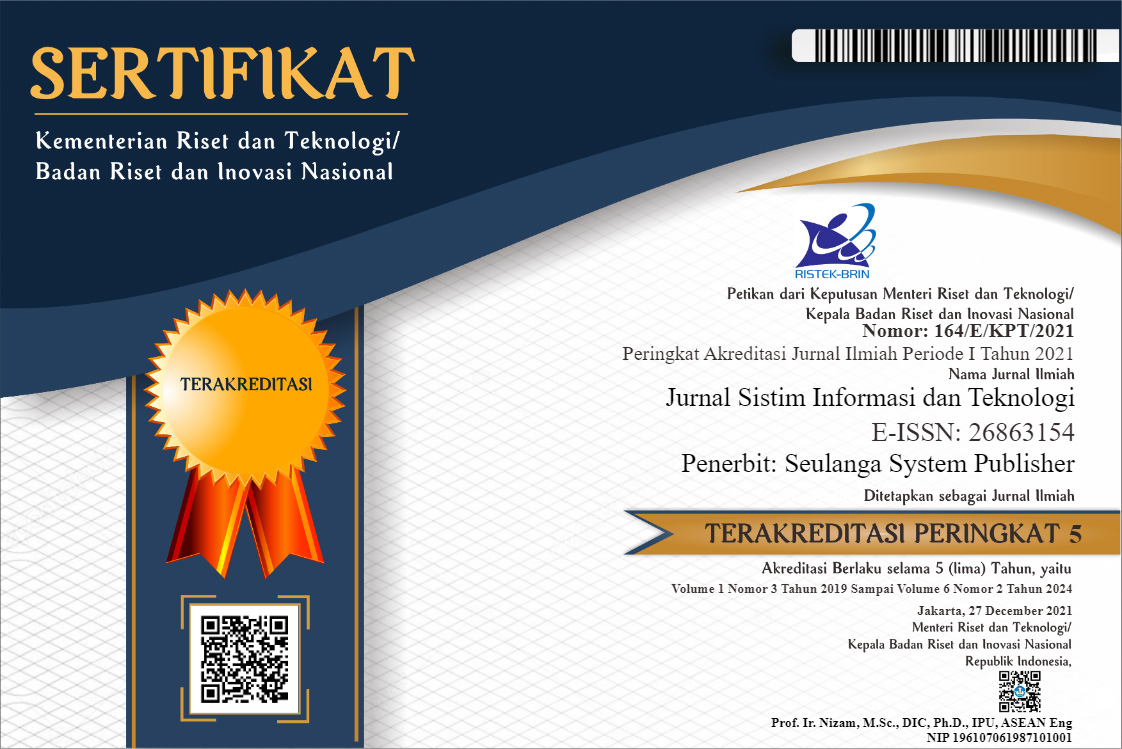The Application of Extended Expectation-Confirmation Model to Identify Influencing Factors Digital Loyalty for Mobile-Based Travel Platform
DOI:
https://doi.org/10.37034/jsisfotek.v5i2.246Keywords:
Digital, Travel Platform, Satisfaction, Expectation-Confirmation ModelAbstract
The aim of this study was to determine the factors that impact the faithfulness of users on digital travel platforms, using the model proposed by researchers on satisfaction and loyalty based on user perceptions using the Expectation-Confirmation Model, which was enhanced by incorporating the variables of security and loyalty. Surveys were distributed online using a purposive sampling technique, and the minimum number of samples was determined using the Slovin formula with a 5% confidence interval. Subsequently, the data collected was analyzed using Ms. Excel and the PLS-SEM approach with SmartPLS. According to the findings of this study, out of the seven hypotheses, two hypotheses from travel A and B were rejected, specifically the security hypothesis regarding satisfaction and the satisfaction hypothesis regarding continuance intention. Similarly, the perceived usefulness hypothesis regarding continuance intention was rejected for travel A and B due to the path coefficient value and t-test of the hypothesis being less than 0.1 and 1.96. However, four hypotheses were accepted for all three platforms. According to the calculation of R2, satisfaction, continuance intention, and perceived utility are the three criteria that have the most impact on loyalty on the three digital travel platforms.
References
Evanschitzky, H., Ramaseshan, B., Woisetschläger, D. M., Richelsen, V., Blut, M., & Backhaus, C. (2012). Consequences of customer loyalty to the loyalty program and to the company. Journal of the Academy of Marketing Science, 40(5), 625–638. https://doi.org/10.1007/s11747-011-0272-3
Violin, V., Hasan, S., & Sufri, M. (2022). Analysis of the Influence of Marketing Technology Concepts, Service Quality, and Low-Cost Carrier on Customers and Customer Loyalty on Lion Air Airlines in Indonesia. Journal of Management Science (JMAS), 5(3), 64-73.
Gustafsson, A., Johnson, M. D., & Roos, I. (2005). The effects of customer satisfaction, relationship commitment dimensions, and triggers on customer retention. Journal of Marketing, 69(4), 210–218. https://doi.org/10.1509/jmkg.2005.69.4.210
Sutrisno, S., Wulandari, W., Violin, V., Supriyadi, A., & Tawil, M. R. (2023). Prioritization of the Best Online Platform for MSMEs Using Simple Additive Weighting Method. Journal on Education, 5(3), 10265-10275.
Halilovic, S., & Cicic, M. (2013). Antecedents of information systems user behaviour- extended expectation-confirmation model. Behaviour and Information Technology, 32(4), 359–370. https://doi.org/10.1080/0144929X.2011.554575
Firdaus, D. R., Harto, B., & Ferdiansyah, H. (2023). The Effectiveness Analysis of Distance Learning by Optimizing the Use of Information Technology. JISTE (Journal of Information System, Technology and Engineering), 1(1), 1–5.
Hilaludin, & Cheng, B. L. (2014). Factors Influencing Customer Satisfaction and E- Loyalty: Online Shopping Environment among the Young Adults. Management Dynamics in the Knowledge Economy, 2(3), 462–471.
Ferdiansyah, H., Komaria, N., & Arief, I. (2023). The Application of Support Vector Machine Method to Analyze the Sentiments of Netizens on Social Media Regarding the Accessibility of Disabilities in Public Spaces. JISTE (Journal of Information System, Technology and Engineering), 1(1), 6–10.
Hsu, C. L., & Lin, J. C. C. (2015). What drives purchase intention for paid mobile apps?- An expectation confirmation model with perceived value. Electronic Commerce Research and Applications, 14(1), 46–57. https://doi.org/10.1016/j.elerap.2014.11.003
Linton, H., & Kwortnik, R. J. P. D. (2015). The Mobile Revolution Is Here: Are You Ready? Cornell Hospitality Report, 15(6), 1–20.
Saufi, M., Rofi’i, A., & Firdaus, D. R. (2023). The Analysis of User Intention to Subscribe Netflix Using UTAUT Framework. JISTE (Journal of Information System, Technology and Engineering), 1(1), 16–20.
Nugroho, A., & Magnadi, R. H. (2018). The Influence of Service Quality on Customer Satisfaction of Lazada Express Shipping Services During Harbolnas in E-Commerce. Jurnal of Management, Vol. 7(No. 4), Hlm. 1-11. http://ejournal- s1.undip.ac.id/index.php/dbr
Rahman, M. S., Khan, A. H., & Mahmudul Haque, M. (2012). A conceptual study on the relationship between service quality towards customer satisfaction: Servqual and gronroos’s service quality model perspective. Asian Social Science, 8(13), 201–210. https://doi.org/10.5539/ass.v8n13p201
Agus Rofi’i, Firdaus, D. R., & Moridu, I. (2023). The Analysis of User Acceptance Using UTAUT and Delone & McLean Model: Study Case of Banking Mobile Application. JISTE (Journal of Information System, Technology and Engineering), 1(1), 21–25.
Utami, B., Hidayat, M. S., & Setyariningsih, E. (2023). The relationship between customer satisfaction and loyalty: A systematic literature review. IJSSR, 3(1), 54-62.
Utami, B., Mukhlis, I., & Murwani, D. (2023). Strategy Internationalization SMEs of Overlay Visualization Bibliometric Analysis: Experiential Marketing, Relationshipand Digital Technology in increasing Consumer Satisfactionin Indonesia. Asian Journal of Community Services, 2(4), 323-332.
Sidharta, I., & Boy Suzanto. (2015). The Influence of Online Shopping Transaction Satisfaction and Consumer Trust on Consumer Attitudes and Behavior in E-Commerce. Jurnal Computech & Bisnis, 1(9), 23–36. ISSN 2442-4943. http://jurnal.stmik-mi.ac.id/index.php/jcb/article/download/124/148
Susanto, A., Lee, H., Zo, H., & Ciganek, A. P. (2013). Factors affecting Internet banking success: A comparative investigation between Indonesia and South Korea. Journal of Global Information Management, 21(2), 72–95. https://doi.org/10.4018/jgim.2013040104
Downloads
Published
How to Cite
Issue
Section
License
Copyright (c) 2023 Jurnal Sistim Informasi dan Teknologi

This work is licensed under a Creative Commons Attribution 4.0 International License.









